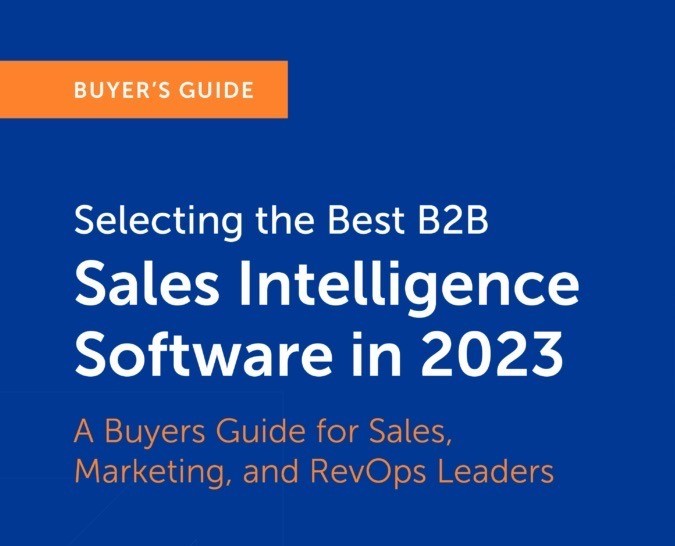Alignment among go-to-market teams has always been difficult. Marketing and sales departments frequently work with their own data sets, knowledge, and procedures, while customer service teams create distinct customer experiences from marketing and sales.
But, aside from the obvious mismatches generated by this working pattern, what is the actual issue caused by misaligned go-to-market teams? Data that is duplicated, erroneous, and harmful to your success.
Data is the lifeblood of your CRM system, and data errors affect the entire system, sales effectiveness, and revenue. Because of mismatched, inconsistent data across your organization, your revenue-generating departments can only respond partially to client demands. After all, your consumers fuel your sales and propel your company forward.
This B2B data buyer’s guide will help you to make the most out of B2B data and choose the right sales intelligence platform to boost your revenue.
Stop Using Bad Data and Data Decay
“Bad Data” is challenging to define. Some consider it a purely technical occurrence with missing numbers, outdated data, and incompatible file formats. These are all important considerations, but bad data is so much more.
Bad data is information that is erroneous, misleading, or does not follow standard formatting conventions. It provides information that takes up your time and leads teams to lose faith in the CRM and one another. It’s data that you can’t access, data that you had but then lost, data that isn’t the same today as it was yesterday, and data that you can’t utilize.
Data might degrade due to a variety of reasons. The typical issue is failing to keep correct client information, such as sales, marketing, and CRM data. In systems constantly changing and improving to fulfill business objectives, connectivity and completeness of data sets can soon become broken and outdated if not appropriately managed. In most firms, there is no one source of data but rather a collection of data sources spanning several platforms, formats, and perspectives.
The human element is another component that contributes to data deterioration. Typically, data is manually inputted at some point during the trip. When incorrect or misspelled data is entered into a system or entered into the wrong place (such as a duplicate), it can result in data consistency, good data hygiene, and deterioration.
To avoid using bad data or to ensure you are using fresh data, you need a sales intelligence platform for accurate prospecting, revenue projections, and setting realistic goals. Implementing database observability can also help ensure that your data is being monitored in real-time, providing insights into its accuracy, performance, and health, which is critical for making data-driven decisions.
How Does a Sales Intelligence Platform Help?
You should have a purpose in mind while using any tool or platform; using software aimlessly has never benefitted anyone. You want to have a planned process before deciding on your Sales Intelligence Platform, so you can guarantee it provides everything your team needs in their day-to-day.
Here are some examples of how Sales Intelligence solutions may help you streamline the sales process:
Filters and list builder: List builders work with filters to help you narrow the objectives from a vast list of data to the most relevant ones.
Lead scoring: Sales Intelligence platforms give comprehensive information about clients/prospects. Scoring leads based on the ICP of rep-selected factors to prioritize leads is simple. Your representatives can pursue the most critical customers first and maximize the likelihood of closing.
Data cleansing: Sales Intelligence includes finding flaws in data, correcting them, normalizing data, de-duping it, and keeping the data up to date.
Alerts: When someone is just beginning their purchase journey, your representative receives an alert allowing you to snag the user early on. Similarly, if a current user starts researching competitors, your customer success team can be notified. You may establish alerts for any moves the buyer makes, key events, and various market trends so that sales employees can capitalize on the new development.
How To Make Sure You Choose the Best Sales Intelligence Platform
There are specific details to watch for that indicate a bad data source. These enable you to locate the best data list supplier for your company.
Review these traits when deciding on a Sales Intelligence Platform for your RevOps team.
What to Look Out For
Accuracy
In past years, data was mainly about the quantity you get at a specific price. More is better was the traditional way of thinking while buying the data. After seeing the data quantity, companies like ZoomInfo were the go-to choice for businesses. However, today, accuracy and relevancy are the keys. So, people are exploring ZoomInfo competitors to get more relevant data than quantity.
We’ve gone from worrying about the cost per data point to the ROI on data purchased. Buying 10,000 contacts isn’t helpful if only 100 are potential customers. Better to have a higher cost per data point if 1,000 are potential customers.
Accuracy and relevancy are the keys. When looking for a B2B marketing data list, you may discover that certain companies overpromise on accuracy. Accuracy is hard to judge, especially if you are new to the market. Ask for a random sample of data in your target market to test yourself before purchasing. If you can’t receive sample data from the platform without the seller double-checking it before sending it over then you should pick someone else.
The highest possible accuracy any provider can have is 95% based on the constant changes and decay inherent in data. People are always switching jobs, roles, and contact information. 100% data accuracy is impossible. If you discover incorrect data in your B2B marketing data list, you’ll want to know whether your provider will update it. Some firms do, while others refuse or struggle to do so promptly.
The list’s precision is what gives it worth. To minimize disappointment, be sure you receive what you pay for regarding accuracy.
Completeness
Do you have all of the necessary information for each of your records?
Incomplete data is common, especially in the early stages of prospecting. However, a consistent absence of crucial data might be a significant concern, particularly when reviewing your marketing and sales funnels.
You must determine what information is critical to which functions and develop methods to collect the information your team needs to do their duties efficiently. Some sales platforms might not have the same definition of a complete data point you do. Make sure you’re on the same page.
For example, are mobile phone numbers included, an extra upcharge, or usually not included?
Consistency
Will your CRM system’s data be consistent with the new platform?
Are your email addresses and phone numbers, for example, already standardized? Is there a grading system in place for the customers and possibilities presented? You’ll want your platform to slot right into your existing systems.
When data is pooled from many sources, data inconsistency arises. Data inconsistencies might result in accurate and trustworthy datasets. Data consistency guarantees that no data fields are mismatched, allowing your team to manage and use the information in your CRM easily.
Uniqueness
Will your new platform clog your CRM with redundant data?
Finding the information that users want may be exceedingly difficult if protocols are not in place to combine and delete duplicate data entries or, better yet, to prevent them from being produced in the first place. Worse, it can interfere with automation by syncing or merging data from inaccurate records or sending duplicate messages.
At the same time, eliminating duplicates at random may result in missing data since the information you seek may be spread over several duplicate entries.
Timeliness
Will you be receiving current data?
Typically, timely data ensures that your CRM’s information is constantly actionable. After all, what’s the use of gathering data if it’s not supporting you in taking action?
Keeping your CRM data trustworthy, relevant, and up-to-date requires constant organization and cleansing. Will the new platform help you keep your data clean over time?
Initially, data is frequently raw. This acquired data is digested into the system as distinct datasets as it flows into a central database. When this happens, data is commonly poured into a data lake, or more precisely, a data swamp, full of raw information that is rarely valuable outside of specific circumstances. Old and new data mix together leading to errors and confusion such as old employees not being deleted from a company’s account, wrong people in job roles, and inaccurate contact information.
How do you want to use the tool?
Expanding on the importance of completeness, what information do you require to close more sales? What data would be nice to have? Is the Sales Intelligence tool equipped with the necessary data to help marketing, sales, and customer service teams? What type of data or characteristics should you look for while purchasing? Along with decision-makers contact information, the following should be included in your Sales Intelligence tool:
Firmographic Data: Firmographic data comprises crucial firm facts such as size and industry that assist you in categorizing accounts (companies) that are appropriate for you.
Technographic Data: Technographic data includes information on the technologies employed by the target accounts/companies.
Work mobile numbers: Work mobile dials have a direct influence on the length of time it takes to locate and reach decision-makers. They assist you in reaching the decision-maker directly, which is especially useful when the deal is nearing completion.
Buyer Intent Data: Buyer Intent Data data assists you in identifying prospects who are actively engaged in a purchasing decision based on the sort of material they consume.
Pricing
A key sign that a provider is not the right fit for you is the price. If you feel your quote is overcharging the data you are buying, then don’t invest. Check a few providers and ask for quotes for similar data lists. Compare what is on offer and the prices that match the offers. If a provider has a price that stands out for being too high then you know to go elsewhere.
Remember you want to know how much you are paying for relevant, actionable data, not per data point.
Compliance
The failure to produce compliance documentation is evidence that a platform is a bad fit. Regardless of the nation you operate in, you should be able to view paperwork proving that the supplier complies with the major data privacy laws. When requested, compliance information should be provided. A lack of documentation is a red indicator that should be avoided.
You don’t want to end up with legal problems because of your platform choice.
The Crucial Role of Data Ewenrichment in 2025
2025 highlights data enrichment as the linchpin for companies striving to gain a competitive edge and foster sustainable growth in their RevOps initiatives.
Why Data Enrichment Matters for RevOps:
1. Precision in Targeting:
Data enrichment empowers RevOps teams to transcend generic lead generation, providing detailed insights into their prospects. By appending additional information such as job titles, company size, and industry trends, companies adopting RevOps can precisely target their audience, fostering more meaningful interactions.
2. Enhanced Lead Scoring:
In 2025, customer intelligence within the RevOps framework emphasizes quality over quantity. Data enrichment facilitates the assignment of accurate lead scores by offering a comprehensive view of each lead’s behavior and preferences. Complex lead scoring enables RevOps teams to prioritize high-value prospects, leading to more efficient and effective conversion strategies.
3. Personalized Customer Experiences:
RevOps principles recognize the importance of personalized experiences in B2B transactions. Data enrichment equips companies with the insights necessary to tailor marketing content and communication, ensuring that interactions are relevant and resonate with the unique needs of each prospect or customer.
4. Staying Compliant:
With escalating data privacy regulations, maintaining compliance is crucial for companies implementing RevOps strategies. Data enrichment assists RevOps teams in ensuring that the information they collect and use is accurate and up-to-date, mitigating the risk of regulatory violations.
Optimizing Website Forms
Efficient Form Filling Process:
Cumbersome forms can act as a deterrent for potential leads. Within a Revenue Operations (RevOps) framework, data enrichment becomes a valuable tool for pre-filling specific fields, reducing the time and effort required for visitors to complete forms. This streamlined approach enhances user experience and boosts form submission rates.
Real-Time Maintenance of Data Accuracy:
Sustaining up-to-date contact information poses an ongoing challenge. RevOps-oriented data enrichment solutions provide real-time updates, ensuring the constant accuracy of information collected through website forms. This saves time for marketing and sales teams and establishes reliable communication channels with prospects.
Tailored Content Recommendations:
Through a RevOps lens, enriched data allows companies to comprehend the preferences and interests of website visitors, enabling dynamic adjustments to the content presented alongside lead forms. This personalized approach effectively engages visitors and heightens the chances of capturing valuable data.
In the context of RevOps, data enrichment transcends being a mere luxury and becomes necessary for companies aiming to thrive in the B2B landscape of 2025. It extends beyond simple data acquisition, providing the tools to comprehend, engage, and convert prospects into long-term customers. Furthermore, when seamlessly integrated into website forms, data enrichment transforms the user experience, fostering stronger connections and contributing to overall business success.
What’s Next?
SalesIntel has supported B2B organizations in closing their dream accounts and bolstering their account-based marketing efforts. Our customers find SalesIntel the best ZoomInfo alternative. We want your team to feel confident when contacting prospects and spend time exclusively on quality leads by keeping your data clean, accurate and enriched.
Gain access to millions of human-verified B2B contacts and maximize the value of your data with features such as buyer intent signals, data enrichment, technographic and firmographic filters, and more. To check the accuracy of our data, start a free trial or request a sample.
Our support system helps you improve efficiency across the RevOps process, drive revenue predictability, and achieve revenue growth. Schedule a personalized SalesIntel demo based on your ideal customer profile to see how many contacts we have for your sales team.







